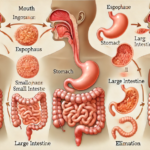Managing diabetes effectively requires a comprehensive approach that includes regular physical activity, medication (if necessary), and a carefully planned diet. Nutrition plays a critical role in controlling blood sugar levels, preventing complications, and promoting overall well-being. This article explores nutritional strategies and dietary guidelines to help individuals with diabetes manage their condition and maintain a healthy lifestyle.
Understanding Diabetes and Nutrition
Diabetes is a chronic condition characterized by high blood sugar levels. It can result from the body’s inability to produce insulin (Type 1 diabetes) or use insulin effectively (Type 2 diabetes). Proper nutrition can help manage blood sugar levels, reduce the risk of complications, and support overall health.
Key Dietary Goals for Diabetes Management
- Control Blood Sugar Levels: Maintaining stable blood glucose levels is crucial for preventing complications associated with diabetes.
- Manage Weight: Achieving and maintaining a healthy weight can improve insulin sensitivity and reduce the risk of complications.
- Reduce Risk of Cardiovascular Disease: A healthy diet can help lower cholesterol levels and blood pressure, reducing the risk of heart disease.
- Provide Adequate Nutrition: Ensuring a balanced intake of nutrients is essential for overall health and well-being.
Nutritional Strategies for Diabetes Management
1. Choose Complex Carbohydrates
Carbohydrates have a significant impact on blood sugar levels. It is essential to choose complex carbohydrates that are digested slowly, leading to a gradual rise in blood sugar.
- Whole Grains: Include whole grains like brown rice, quinoa, whole wheat bread, and oats. They are high in fiber and have a lower glycemic index (GI) compared to refined grains.
- Legumes: Beans, lentils, and chickpeas are excellent sources of complex carbohydrates and protein.
- Vegetables: Non-starchy vegetables like leafy greens, broccoli, and bell peppers are low in carbohydrates and rich in nutrients.
2. Monitor Carbohydrate Intake
Counting carbohydrates can help manage blood sugar levels. Understanding portion sizes and the carbohydrate content of foods can aid in meal planning.
- Carb Counting: Work with a healthcare professional to determine your daily carbohydrate intake and distribute it evenly throughout the day.
- Use Glycemic Index: The glycemic index measures how quickly a food raises blood sugar levels. Foods with a low GI are preferable as they cause a slower, more controlled rise in blood sugar.
3. Include Lean Proteins
Protein helps stabilize blood sugar levels and provides a feeling of fullness. Opt for lean protein sources that are lower in saturated fats.
- Animal Proteins: Skinless poultry, lean cuts of beef and pork, fish, eggs, and low-fat dairy products.
- Plant Proteins: Tofu, tempeh, edamame, lentils, beans, and nuts.
4. Incorporate Healthy Fats
Healthy fats are essential for overall health and can help improve blood lipid levels. Focus on unsaturated fats while limiting saturated and trans fats.
- Monounsaturated Fats: Avocados, olive oil, nuts, and seeds.
- Polyunsaturated Fats: Fatty fish (such as salmon, mackerel, and sardines), walnuts, flaxseeds, and chia seeds.
- Avoid Trans Fats: Found in partially hydrogenated oils, fried foods, and some baked goods.
5. Increase Fiber Intake
Fiber slows down the absorption of sugar and can help regulate blood sugar levels. It also promotes digestive health and can aid in weight management.
- Sources of Soluble Fiber: Oats, barley, apples, pears, beans, and lentils.
- Sources of Insoluble Fiber: Whole grains, vegetables, nuts, and seeds.
6. Limit Added Sugars and Refined Carbohydrates
Minimize the intake of added sugars and refined carbohydrates, which can cause rapid spikes in blood sugar levels.
- Avoid Sugary Drinks: Sodas, fruit juices, and energy drinks are high in added sugars.
- Choose Whole Foods: Opt for whole, unprocessed foods over packaged and processed items.
7. Stay Hydrated
Proper hydration is essential for overall health and can help manage blood sugar levels.
- Water: Drink plenty of water throughout the day.
- Limit Sugary Beverages: Avoid sweetened drinks and opt for water, herbal teas, or unsweetened beverages.
8. Plan Balanced Meals
Creating balanced meals that include a variety of nutrients is key to managing diabetes.
- Plate Method: Fill half your plate with non-starchy vegetables, one-quarter with lean protein, and one-quarter with complex carbohydrates. Add a serving of healthy fat.
Special Considerations for Different Types of Diabetes
Type 1 Diabetes
Individuals with Type 1 diabetes need to match their carbohydrate intake with insulin administration. It is crucial to work with a healthcare provider to adjust insulin doses based on meal planning.
Type 2 Diabetes
For those with Type 2 diabetes, weight management and controlling blood sugar levels are primary goals. A balanced diet, regular physical activity, and possibly medication are essential components of treatment.
Gestational Diabetes
Gestational diabetes occurs during pregnancy and requires careful monitoring of blood sugar levels. A balanced diet, regular exercise, and monitoring blood sugar levels are crucial.
Tips for Meal Planning and Preparation
1. Meal Prep and Planning
Plan meals and snacks ahead of time to ensure a balanced intake of nutrients and avoid impulsive eating.
2. Portion Control
Use measuring cups, a food scale, or visual cues to help manage portion sizes and control carbohydrate intake.
3. Read Food Labels
Understanding food labels can help identify hidden sugars, unhealthy fats, and carbohydrate content.
4. Eat Regularly
Eating at regular intervals can help maintain stable blood sugar levels and prevent spikes and drops.
5. Mindful Eating
Pay attention to hunger and fullness cues, eat slowly, and savor your food to prevent overeating.
Conclusion
Managing diabetes through a balanced and carefully planned diet is essential for controlling blood sugar levels, maintaining a healthy weight, and reducing the risk of complications. By choosing nutrient-dense foods, monitoring carbohydrate intake, and incorporating healthy fats and proteins, individuals with diabetes can enjoy a variety of delicious and satisfying meals. It is important to work with healthcare professionals, such as dietitians and doctors, to create a personalized nutrition plan that meets individual needs and goals.
FAQs
What foods should be avoided in a diabetic diet?
Individuals with diabetes should avoid foods high in added sugars, refined carbohydrates, and unhealthy fats. This includes sugary drinks, sweets, pastries, fried foods, and processed snacks.
Can people with diabetes eat fruit?
Yes, people with diabetes can eat fruit in moderation. Choose whole fruits over fruit juices and be mindful of portion sizes. Opt for fruits with a lower glycemic index, such as berries, apples, and pears.
Is it necessary to eat at the same time every day?
Eating at regular intervals can help maintain stable blood sugar levels. While it is not necessary to eat at the exact same time every day, maintaining a consistent meal schedule can be beneficial.
Can alcohol affect blood sugar levels?
Yes, alcohol can affect blood sugar levels. It can cause blood sugar to rise initially and then drop to dangerous levels. It is important to consume alcohol in moderation and consult with a healthcare provider.
What are some healthy snack options for people with diabetes?
Healthy snack options for people with diabetes include Greek yogurt with berries, a handful of nuts, carrot sticks with hummus, apple slices with almond butter, and a small portion of whole-grain crackers with cheese.
How can I manage diabetes without medication?
For some individuals with Type 2 diabetes, lifestyle changes such as a balanced diet, regular physical activity, weight management, and stress reduction can help manage blood sugar levels without medication. However, it is important to work with a healthcare provider to determine the best approach.



